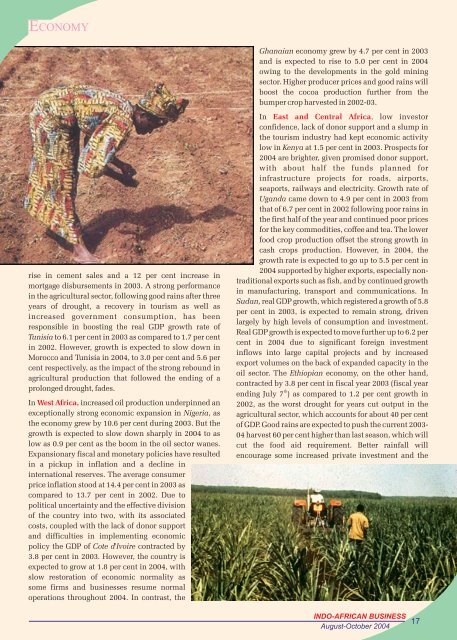ECONOMYGhanaian economy grew by 4.7 per cent in 2003<strong>and</strong> is expected to rise to 5.0 per cent in 2004owing to the developments in the gold miningsector. Higher producer prices <strong>and</strong> good rains willboost the cocoa production further from thebumper crop harvested in 2002-03.In East <strong>and</strong> Central <strong>Africa</strong>, low investorconfidence, lack of donor support <strong>and</strong> a slump inthe tourism industry had kept economic activitylow in Kenya at 1.5 per cent in 2003. Prospects for2004 are brighter, given promised donor support,with about half the funds planned forinfrastructure projects for roads, airports,seaports, railways <strong>and</strong> electricity. Growth rate ofUg<strong>and</strong>a came down to 4.9 per cent in 2003 fromthat of 6.7 per cent in 2002 following poor rains inthe first half of the year <strong>and</strong> continued poor pricesfor the key commodities, coffee <strong>and</strong> tea. The lowerfood crop production offset the strong growth incash crops production. However, in 2004, thegrowth rate is expected to go up to 5.5 per cent in2004 supported by higher exports, especially nonrisein cement sales <strong>and</strong> a 12 per cent increase intraditional exports such as fish, <strong>and</strong> by continued growthmortgage disbursements in 2003. A strong performancein manufacturing, transport <strong>and</strong> communications. Inin the agricultural sector, following good rains after threeSudan, real GDP growth, which registered a growth of 5.8years of drought, a recovery in tourism as well asper cent in 2003, is expected to remain strong, drivenincreased government consumption, has beenlargely by high levels of consumption <strong>and</strong> investment.responsible in boosting the real GDP growth rate ofReal GDP growth is expected to move further up to 6.2 perTunisia to 6.1 per cent in 2003 as compared to 1.7 per centcent in 2004 due to significant foreign investmentin 2002. However, growth is expected to slow down ininflows into large capital projects <strong>and</strong> by increasedMorocco <strong>and</strong> Tunisia in 2004, to 3.0 per cent <strong>and</strong> 5.6 perexport volumes on the back of exp<strong>and</strong>ed capacity in thecent respectively, as the impact of the strong rebound inoil sector. The Ethiopian economy, on the other h<strong>and</strong>,agricultural production that followed the ending of acontracted by 3.8 per cent in fiscal year 2003 (fiscal yearprolonged drought, fades.thending July 7 ) as compared to 1.2 per cent growth inIn West <strong>Africa</strong>, increased oil production underpinned an 2002, as the worst drought for years cut output in theexceptionally strong economic expansion in Nigeria, as agricultural sector, which accounts for about 40 per centthe economy grew by 10.6 per cent during 2003. But the of GDP. Good rains are expected to push the current 2003-growth is expected to slow down sharply in 2004 to as 04 harvest 60 per cent higher than last season, which willlow as 0.9 per cent as the boom in the oil sector wanes. cut the food aid requirement. Better rainfall willExpansionary fiscal <strong>and</strong> monetary policies have resulted encourage some increased private investment <strong>and</strong> thein a pickup in inflation <strong>and</strong> a decline ininternational reserves. The average consumerprice inflation stood at 14.4 per cent in 2003 ascompared to 13.7 per cent in 2002. Due topolitical uncertainty <strong>and</strong> the effective divisionof the country into two, with its associatedcosts, coupled with the lack of donor support<strong>and</strong> difficulties in implementing economicpolicy the GDP of Cote d'Ivoire contracted by3.8 per cent in 2003. However, the country isexpected to grow at 1.8 per cent in 2004, withslow restoration of economic normality assome firms <strong>and</strong> businesses resume normaloperations throughout 2004. In contrast, theINDO-AFRICAN BUSINESS 17August-October 2004
ECONOMYeconomy is also expected to benefitfrom debt relief <strong>and</strong> donor support.Services (transport, financial <strong>and</strong>communications) will continue tobenefit from increased trade activities<strong>and</strong> rising investment over the forecastperiod. The real GDP growth is thusexpected to rebound to 6.7 per cent in2003-04.Real GDP Growth & Inflation in Select <strong>Africa</strong>n CountriesReal GDP Growth (%) Consumer Prices (%)2002 2003 2004f 2005f 2002 2003 2004f 2005f<strong>Africa</strong> 3.5 4.1 4.2 5.4 9.6 10.3 8.6 6.7Mahgreb 3.4 6.2 4.2 4.5 2.1 2.2 3.0 3.1Algeria 4.1 6.7 4.4 4.3 1.4 2.6 3.8 4.0Morocco 3.2 5.5 3.0 4.0 2.8 1.2 2.0 2.0Tunisia 1.7 6.1 5.6 6.0 2.8 2.7 2.7 2.5In Southern <strong>Africa</strong>, although oilproduction fell in Angola in 2003, owingto problems with the Kuito field, the Sub-Sahara 3.4 4.4 5.1 7.0 14.0 17.4 14.8 9.2steady increase in production in recent Ethiopia 1.2 -3.8 6.7 6.4 -7.2 15.1 5.5 3.0years is set to continue as <strong>new</strong> oilfields Sudan 6.0 5.8 6.2 6.5 8.3 7.7 6.5 6.0come on stream. This will help to boost Congo D.R. 3.5 5.0 6.0 7.0 27.7 9.1 6.0 5.0real GDP to 12.8 per cent in 2004 <strong>and</strong> Kenya 1.0 1.5 2.6 3.6 2.0 9.7 -0.2 3.411.2 per cent in 2005, although this Tanzania 6.3 5.5 6.3 6.5 4.6 5.0 4.7 3.8energy driven growth will be capitalintensiveUg<strong>and</strong>a 6.7 4.9 5.5 6.2 5.7 5.9 3.5 3.5<strong>and</strong> import-dependent, with Angola 15.3 4.5 12.8 11.2 108.9 98.3 40.2 15.9few linkages to other sectors of the Zimbabwe -12.8 -13.2 -9.2 5.2 140.0 431.7 640.0 200.0economy. The average annual rate ofGhana 4.5 4.7 5.0 5.0 14.8 26.4 8.6 6.0Nigeria 1.5 10.6 0.9 5.9 13.7 14.4 16.5 10.1inflation fell to 98.3 per cent in 2003,Cameroon 6.5 4.2 4.7 5.1 6.3 1.2 2.0 2.0representing a drop into double digitsCote d'Ivoire -1.6 -3.8 1.8 4.4 3.1 3.8 3.2 2.7for the first time in over a decade. Thiswas supported by measures like costlyintervention in the foreign exchangeSouth <strong>Africa</strong> 3.6 1.9 2.6 3.2 8.9 6.0 3.2 5.6market to prop up the kwanza <strong>and</strong>f- forecastsdelays in increasing the prices of fuelSource, International Monetary Fund<strong>and</strong> utilities. Economic activity inZimbabwe is set to continue declining asNotwithst<strong>and</strong>ing the important progress that is beingthe current political crisis <strong>and</strong> the lack of coherentmade, the challenge remains to achieve strong growtheconomic policy combined with the disruptions in theacross <strong>Africa</strong> on a sustained basis. Even during the recenteconomy caused by the rapid implementation of the l<strong>and</strong>period of improved growth in the region, there have beenreform programme <strong>and</strong> the adverse impacts of droughtlarge cross-country differentials. Over the past three<strong>and</strong> AIDS. In addition to this, the slump in commercialyears, real per capita GDP has declined in nearly oneagricultureis having adverse effects on industry <strong>and</strong>third of the <strong>Africa</strong>n countries, while only a small numberservices, purchasing power is falling <strong>and</strong> nearhaverealized real per capita GDP growth in excess of 4.0hyperinflation persists. GDP contracted by around 40 perper cent. For making significant inroads into poverty, thecent during 1999-2003, <strong>and</strong> the economic decline isperformances of the faster-growing countries need to beexpected to slow down to a rate of 9.2 per cent in 2004,replicated throughout the region. Of particularfrom that of 13.2 per cent in 2003, as the small-scaleimportance are steps to develop infrastructure <strong>and</strong>farmers boost maize production in 2004-05. In South<strong>Africa</strong>, the economy is estimated to have exp<strong>and</strong>ed bystrengthen institutions, promote private sectorjust 1.9 per cent in 2003, as the weak global economyinvestment, reduce government involvement in thecoupled with the strengthening of the r<strong>and</strong> during thedomestic economy, improved governance <strong>and</strong>year, had an adverse effect on the export sector'stransparency. Some regional initiatives, including thecontribution to overall GDP. Although sluggish growth <strong>Africa</strong>n Peer Review Mechanism for economic <strong>and</strong>was also posted for agriculture, mining <strong>and</strong> political governance launched through the Newmanufacturing, tourism continued to grow strongly, Partnership or <strong>Africa</strong>'s Development (NEPAD), <strong>and</strong> thebenefiting from the cricket World Cup. However, real <strong>Africa</strong>n Union's adoption of a Convention on PreventingGDP growth is forecast to increase to 2.6 per cent in 2004 <strong>and</strong> Combating Corruption have already been put in<strong>and</strong> the main boost to growth will come from gross fixed place. The international community has a key role to playinvestment as privatisation gathers pace <strong>and</strong> inflows of in <strong>Africa</strong>'s development, including higher aid flows, debtforeign direct investment increase.relief, <strong>and</strong> enhanced exchange of trade <strong>and</strong> technology.INDO-AFRICAN BUSINESS 18August-October 2004

















